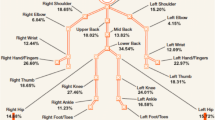Abstract
Using questionnaires, we analyzed associations between different pain variables (e.g., pain intensity) and age (20-65+ years) among 949 primary pain patients. Older patients (a) were more often divorced, were blue-collar workers, were less educated, and had greater difficulties with living expenses; (b) had pain of longer duration, more frequently and of more complexity, and felt more disabled; (c) consumed more painkillers, analgesics, sedatives, and other medications, and had received more pain treatments; and (d) had more health problems. Younger patients had more severe pain, were financially strained, and were more often unemployed. A multivariate regression analysis showed that high disability was more determined by older than young age. However, other factors (e.g., pain complexity) were also important. Thus, older and younger patients experienced their pain differently.
Similar content being viewed by others
References
Arnér, S. (1984). Clinical pain analysis-somatic aspects.Klinik och Terapi (ASTRA),1, 9–12.
Aronoff, G. M., & Evans, W. O. (1982). The prediction of treatment outcome ata multidisciplinary pain center.Pain, 14, 67–73.
Carlsson, A. M. (1984). Assessment of chronic pain. II. Problems in the selection of relevant questionnaire items for classifications of pain and evaluation and prediction of therapeutic effects.Pain, 19, 173–184.
Crook, J., Rideout, E., & Browne, G. (1984). The prevalence of pain complaints in a general populations.Pain, 18, 299–314.
Crook, J., Weir, R., & Tunks, E. (1989). An epidemiological follow-up survey of persistent pain sufferers in a group family practice and specialty pain clinic.Pain, 36, 49–61.
Cutler, R. B., Fishbain, D. A., Rosomoff, R. S., & Rosomoff, H. L. (1994). Outcomes in treatment of painingeriatric and younger agegroups.Archives of Physical Medical Rehabilitation, 75, 457–464.
Demlow, L., Liang, M., & Eaton, H. (1986). Impact of chronic arthritis on the elderly.Clinical Rheumatism Disease, 12, 329–335.
Deyo, R. A., & Tsui-Wu, Y. J. (1987). Descriptive epidemiology of low-back pain and its related medical care in the United States.Spine, 12, 264–268.
Evans, E. R., Rendell, M. S., Barttek, J. P., Bamisedum, O., Lonnor, S. et al. (1992). Current perception thresholds in ageing.Age and Ageing, 21, 273–279.
Fry, P. S., & Wong, P. T. P. (1991). Pain management training in the elderly: Matching interventions with subjects’ coping styles.Stress Medicine, 7, 93–98.
Grossi, G. (1999).The stress of unemployment: Coping patterns, psychological and physiological responses and implications for health. Unpublished dissertation, Department of Psychology, Division of Biological psychology, University of Stockholm, Sweden.
Harkins, S. W. (1988). Pain in the elderly. In R. Dubner, F. G. Gebhart, & M. R. Bond (Eds.),Proceedings of the 5th World Congress on Pain (pp. 355–357). Amsterdam, The Netherlands: Elsevier.
Harkins, S. W., & Price, D. D. (1992). Assessment of pain in the elderly. In D. C. Turk & R. Melzack (Eds.),Handbook of pain assessment (pp. 315–331). New York: Guilford.
Kaplan, R., & Kepes, E. (1989).Pain problems over 70 and under 40 years. Paper presented at the meeting of the American Pain Society, Phoenix, Arizona.
Kee, W. G., Middaufg, S. J., & Pawlick K. L. (1996). Persistent pain in the older patient: Evaluation and treatment. In R. J. Gatchel & D. C. Turk (Eds.),Psychological approaches to pain management: A practitioner’s handbook (pp. 371–402). New York: Guildford.
Keefe, F. J., & Williams, D. A. (1990). A comparison of coping strategies in chronic pain patients in different age groups.Journal of Gerontology, 45, 161–165.
Kwentus, J. A., Harkins, S. W., Lignon, N., & Silverman, J. J. (1985). Current concepts in geriatric pain and its treatment.Geriatrics, 40, 48–54.
Melding, P. (1991). Is there such a thing as geriatric pain?Pain, 46, 119–121.
Melzack, R. (1973).The puzzle of pain. New York: Basic Books.
Peate, W. F. (1994). Occupational musculoskeletal disorders.Occupational Health, 21, 313–327.
Ratti, N., & Pilling, K. (1997). Back pain in the workplace.British Journal of Rheumatology, 36, 260–264.
Shelerud, R. (1998). Epidemiology of occupational low back pain.Occupational Medicine 13, 1–22.
Soares, J. J. F., & Grossi, G. (1999). Experience of musculoskeletal pain: Comparison of immigrant and Swedish patients.Scandinavian Journal of Caring Sciences, 13, 254–266.
Socialstyrelsen. (1987).Kassifikation av sjukdomar. Systematisk förteckning [International Classification of Diseases, Ninth Revision; ICD-9]. Stockholm, Sweden: Liber förlaget.
SoS-rapport. (1995).Invandrares hälsa och sociala förhållanden [Immigrants health and social conditions]. Stockholm, Sweden: National Board of Health and Welfare.
SoS-rapport. (1998).Invandrares levnadsvillkor. Levnadsförhållanden hos fyra invandrargrup-per födda i Chile, Iran, Polen och Turkiet [Living conditions among four groups of immigrants born in Chile, Iran, Poland and Turkey]. Stockholm, Sweden: National Board of Health and Welfare.
Statistics Sweden. (2000). [In Swedish].SCB. Statistical Yearbook of Sweden.
Taeber, C. (1990). Diversity: The dramatic reality. In S. Bass, E. Kutza, & F. Torres-Gil (Eds.),Diversity in aging: The issues facing the White House conference on aging and beyond (pp. 1–45). Glenview, IL: Scott, Foresman.
Thomas, M. R., & Roy, R. (1988). Age and pain: A comparative study of the younger and older elderly.Journal of Pain Management, 1, 174–179.
Thomas, P. S., Kepes, E. R., & Marcus, N. J. (1981). Critical evaluation of 110 geriatric patients in pain treatment center.Pain, 1, S297.
Wilcox, S. M., Hgimmelstein, D. V., & Woolhler, S. (1994). Inappropriate drug prescribing for the community-dwelling elderly.Journal of the American Medical Association, 272, 292–296.
Wood, P. H. N., & Badley, E. M. (1980). Back pain in the community.Clinical Rheumatism Diseases, 6, 3–16.
Author information
Authors and Affiliations
Corresponding author
Rights and permissions
About this article
Cite this article
Soares, J.J.F., Sundin, Ö. & Grossi, G. Age and musculoskeletal pain. Int. J. Behav. Med. 10, 181–190 (2003). https://doi.org/10.1207/S15327558IJBM1002_07
Issue Date:
DOI: https://doi.org/10.1207/S15327558IJBM1002_07



